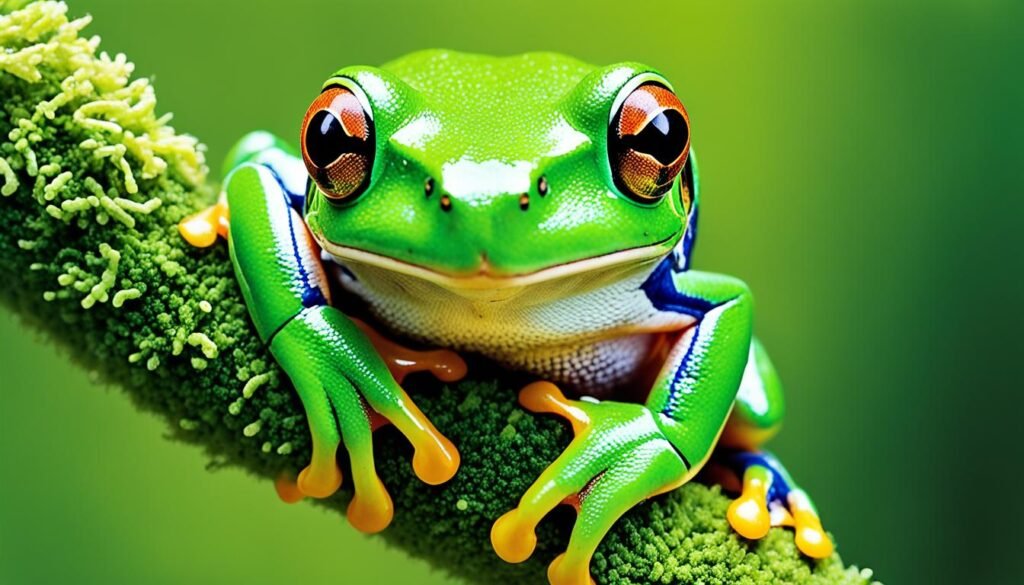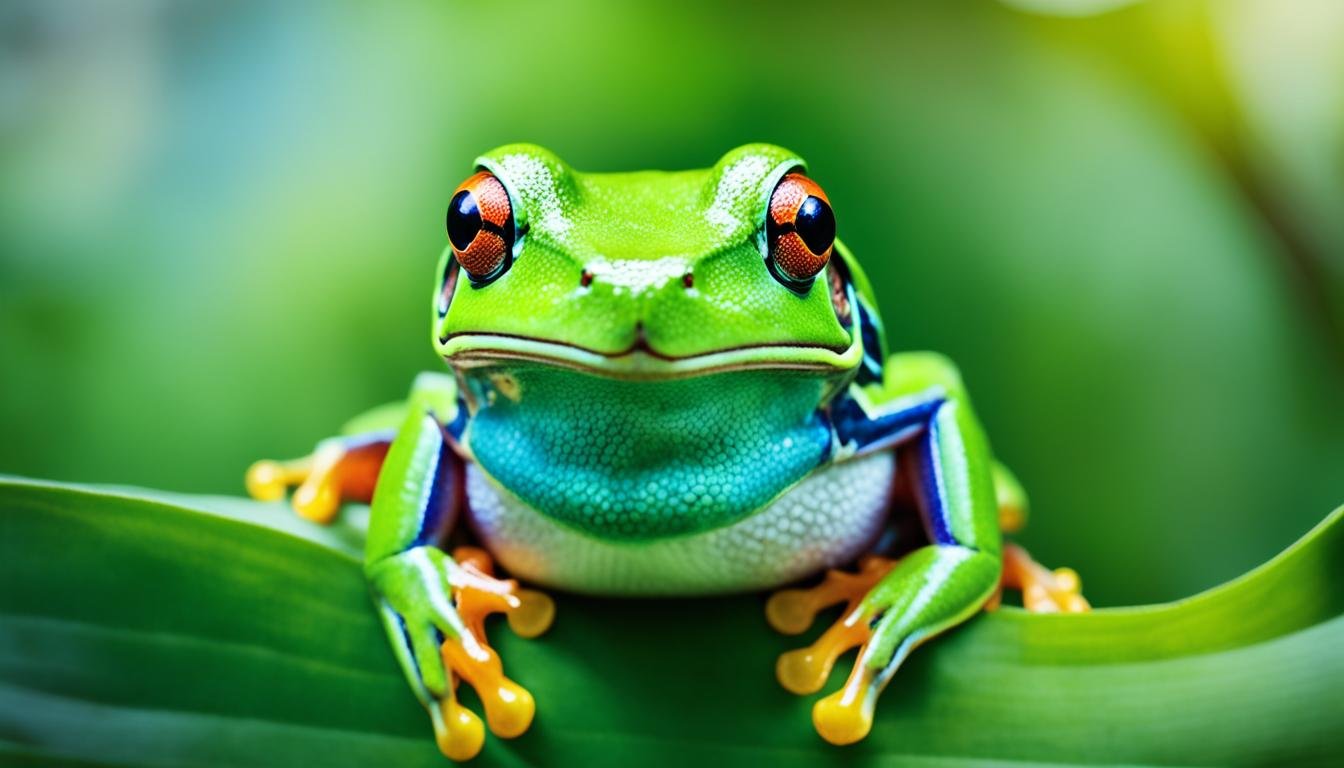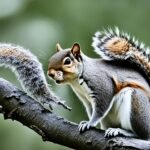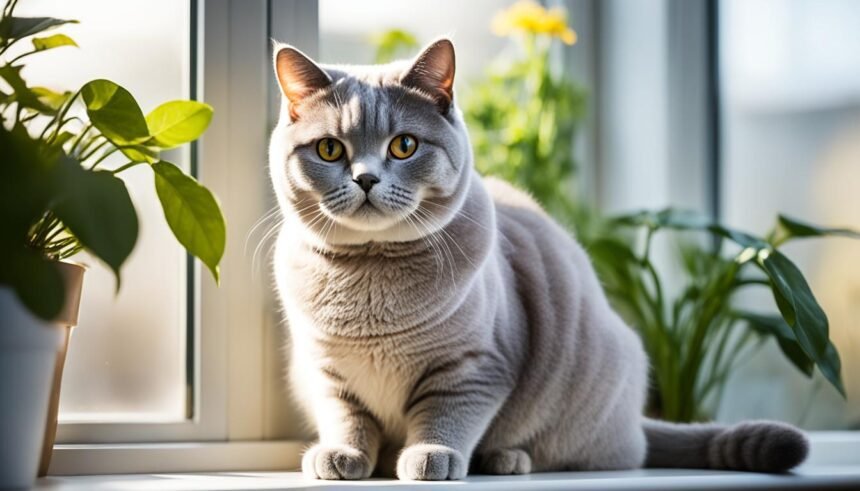The Australian Green Tree Frog is a bright symbol of Australia’s wild nature. These frogs live in varied places, from rainforests to deserts that rarely see rain. They need fresh water to breed, showing how balanced their homes must be.
At night, these frogs look for food and friends under the starry sky. Their skin helps them live at night but also makes them sensitive to pollution. When you see an Australian Green Tree Frog, it means the area is healthy and full of life.
Introduction to the Australian green tree frog
The Australian green tree frog, known as Litoria caerulea, is also called the dumpy tree frog. It lives in Australia, southern New Guinea, and parts of Indonesia. Its bright green color and large size have made it popular among scientists and pet owners alike. This frog has been introduced to places like Florida and New Zealand as well.
The conservation status of this frog is stable, thanks to protection laws. It’s listed as “least concern” by the IUCN and is protected in Australia. This frog adapts well to different environments, which helps keep its population steady. They can live up to 23 years in aquariums, showing they thrive with good care.
| Characteristic | Description |
|---|---|
| Adult Size | Females 3.9 – 5.9 inches; Males slightly smaller |
| Reproduction | 200 – 300 brown eggs, usually laid in shallow water |
| Habitat Size | Minimum 15-gallons for up to 4 adults |
| Temperature | Nighttime 65–68°F, Daytime 72–80°F |
| Habitat Humidity | Ideal range 70–90% |
| Water Depth | 1–2 inches in habitat |
| Cleaning Frequency | At least once a month |
| Feeding – Juveniles | Daily |
| Feeding – Adults | Every other day |
| UVB Light Exposure | 10–12 hours daily |
The comfort and health of the Australian green tree frog depend on its home. This frog lives in wet areas like swamps and ponds. It can also live in moist gardens. Its diet includes insects and small animals, showing it adapts easily to different foods.
Learning about the Litoria caerulea is not just for science. It helps us value an important part of our ecosystem. By understanding more about this frog, we connect with the world around us in deeper ways.
An Overview of the Australian green tree frog’s Native Environment
The Australian green tree frog stands out in the tropical regions and subtropical regions of Australia and New Guinea. It’s known for adapting well to human-altered landscapes. Let’s explore its home and how it adapts.
Tropical and Subtropical Regions of Australia and New Guinea
In tropical regions and subtropical regions, this frog thrives. Its survival skills are tested in different habitats. These areas offer environments like rainforests and wetlands, perfect for their life.
This frog lives across a vast area, over 4,078,600 square kilometers. It calls many places home, from Eucalyptus forests to inland water areas. This shows their wide range of habitat preferences.
Adaptation to Human Altered Landscapes
The green tree frog has learnt to live alongside humans. They are often seen in homes or on windows, adjusting well to new surroundings. They even hunt under artificial lights, showing clever behavior.
| Statistic | Data |
|---|---|
| Average Length | 10 cm or more |
| Average Lifespan in Captivity | Approximately 16 years |
| Conservation Status | Least Concern (IUCN) |
| Introduced Populations | United States (Florida), New Zealand (historic) |
| Habitat Preferences | Rainforests, moist forests, swamps, grasslands, urban areas |
| Antibacterial Properties | Skin secretions with antibacterial and antiviral properties |
These frogs have managed to succeed where other amphibians face decline. They benefit from skin secretions that fight off threats. This gives them an edge against environmental challenges.
The Australian green tree frog’s home ranges from untouched areas to urban places. It’s an expert at adapting to both wild and human spaces. This tells us a lot about surviving and thriving in changing environments.
Physical Characteristics of the Australian green tree frog

The Australian green tree frog, often called White’s tree frog (Litoria caerulea), is unique because of its physical characteristics. These include its size, color, and special features.
This frog’s color can be a bright emerald or a softer olive green. The shade changes with the environment and temperature. Concerning size, females can grow up to 5.9 inches (15 centimeters), which is quite large. Males are typically an inch smaller than females, showing clear size differences between the sexes.
One funny trait of the White’s tree frog is the fatty ridge above their eyes. It makes them look sleepy. Male frogs have grayish, wrinkled vocal sacs that stand out when they sing at night.
Females lay 200 to 300 eggs at a time, which turn into tadpoles in just 1 to 3 days. This quick change is vital for their survival in their fast-changing homes.
Yet, these remarkable frogs are endangered by activities like land development, farming, pollution, and diseases such as the chytrid fungus. This fungus is dangerous to many amphibians worldwide.
But there is still hope for these frogs. They are considered to be of ‘least concern’ for extinction because they live in many places and are thought to have large numbers. They can live in both wetlands and cities, proving they are very adaptable.
| Characteristic | Description |
|---|---|
| Size (Female) | 3.9 to 5.9 inches (10 to 15 cm) |
| Size (Male) | Around 1 inch (2.54 cm) smaller than females |
| Color Variations | Emerald to olive green |
| Eyes | Distinctive fatty ridge above |
| Vocal Sac (Male) | Grayish, wrinkled located underneath the throat |
| Reproduction | 200-300 eggs per clutch, 2,000-3,000 total eggs over a season |
| Metamorphosis Duration | 2-3 weeks from tadpole to froglet |
| Conservation Status | Listed as ‘Least Concern’ on IUCN Red List |
Learning about the Australian green tree frog’s physical characteristics is fascinating. We see the differences in size and the important features that make them stand out. Plus, we understand the risks they face. This highlights the importance of ongoing studies and conservation efforts to protect them.
Distribution and Habitat Preferences of the Australian green tree frog
The Australian Green Tree Frog stands out for its bright color and adaptability. It’s found across a wide area in Northern and Eastern Australia. This frog likes places with lots of water, even in dry areas. This shows how tough and adaptable they are.
Across Northern and Eastern Australia
These frogs live in Northern and Eastern Australia. You’ll see them in green, water-rich places like rainforests and wetlands. But they also live near people, in places changed by humans.
Utilization of Water Sources in Arid Regions
Even in dry places, the Australian Green Tree Frog thrives. They use these areas to live and grow. This makes them very important for the environment.
| Frog Species | Size (mm) | Preferred Habitat |
|---|---|---|
| Litoria gracilenta | up to 45 | Streamside vegetation, plantation crops |
| Litoria caerulea | M: up to 77, F: up to 110 | Moist urban areas like laundries |
| Litoria chloris | M: up to 62, F: up to 68 | Forest pools, streams |
| Litoria citropa | up to 60 | Streams in dense forests |
Frog species adapt differently to changing environments. For example, they change when they breed. They start breeding earlier or for a longer time. They also move their nesting places. This is to deal with changes made by humans. Studies show these frogs are really good at adapting. They manage to keep their unique sounds even when their world changes.
Litoria caerulea in Captivity: Impacts on Natural Behaviors
The pet trade’s demand for Australian green tree frogs, Litoria caerulea, in captivity brings challenges. These challenges significantly affect their natural behaviors and cause behavioral changes. Understanding these effects is key to their conservation and well-being. Research and observations have highlighted how life in captivity changes their instinctive behaviors.
- Grooved toadstools in the vicinity: Their specific humidity and temperature needs are crucial for their energy and health.
- Thriving in still waters: In the wild, they need calm water for breeding, but captivity can change this.
- Alterations in social interactions: Captivity blurs natural social structures, leading to possible stress and aggression.
| Statistic | Impact on Captive Frogs | Considerations for Care |
|---|---|---|
| Breeding success in captivity | 95% egg hatch rate | Ensure a stable and species-specific environment is maintained |
| Tadpole growth | Average body length of 4cm | Monitor for proper development, provide adequate nutrients |
| Metamorphosis outcomes | 18 young frogs emerged | Adjust enclosure to accommodate growing juveniles |
| Behavioral changes due to chytridiomycosis (Bd) | Altered behaviors leading to higher capture rates | Quarantine new individuals, rigorous disease management protocols |
| Toe pad morphology disruption by Bd | Potential impairment in climbing and substrate interaction | Regular health checks, modify enclosures to minimize stress |
We can reduce problems in captivity with careful attention to care and habitat. Laws like the Wildlife Act 1975 set rules for owning and breeding Litoria caerulea. In Victoria, the Department demands specific licenses. Clean handling and strict quarantines maintain health and fight diseases like chytridiomycosis. Together, laws and good care practices protect captive frogs. They help them display more natural behaviors, even in captivity.
The Unique Adaptations of the Australian green tree frog

The Australian green tree frog has unique abilities that help it live in different places. It’s known for its skin that fights off germs, thanks to special secretions. This keeps the frog healthy by preventing infections. Furthermore, its habits at night and what it chooses to eat help it survive and keep the food chain going.
Skin Secretions and their Antibacterial Properties
The skin of this frog releases helpful substances, like alkaloids and peptides. These provide protection against bacteria and fungi. Scientists are interested in these secretions for creating new medicines. Thus, this frog’s skin is a great subject for studying how animals can help in medical discoveries.
Nocturnal Feeding Habits and Dietary Preferences
This frog likes to eat at night, avoiding competitors and predators. It mainly eats insects and small creatures. This eating pattern helps maintain its crucial role in nature as a predator.
| Characteristic | Description | Significance |
|---|---|---|
| Adaptive Skin Secretions | Produces substances like alkaloids with antibacterial effects. | Demonstrates the potential for medical applications and environmental adaptability. |
| Burrowing Capability | Able to burrow up to a meter underground during dry conditions. | Exemplifies behavioral adaptation to changing environments. |
| Salinity Tolerance | Coastal populations can tolerate higher salinity levels (up to 20 ppt). | Indicates the possibility of local adaptation in response to sea-level rise. |
| Reproductive Success | Coastal frogs have higher hatching rates in salty environments. | Shows physical and reproductive changes aiding survival in varied habitats. |
Looking into these frog adaptations is key for wildlife care and saving efforts. Projects like FrogID help track invasive species like the Cane Toad. They also help us understand how pollution and other factors affect frog populations. This is vital to keep ecosystems balanced, where frogs are important predators and prey.
Ecosystem Roles and Human Interactions
The Australian green tree frog is a special kind of species. It plays a big role in keeping its ecosystem roles balanced. By eating insects, they control pest populations and keep nature healthy. These frogs are also important to people. They help in research and are part of the pet trade.
It’s vital to make efforts to conserve the Australian green tree frog. This involves protecting their homes and understanding how to care for them in captivity. Scientists, conservationists, and policy-makers work together. They showcase the frog’s deep ecological value and why we should save diverse species for the future.
- Plays a critical role in regulating insect populations, including pests
- Interactions with humans span education, conservation, and scientific research
- Conservation efforts are essential to mitigate habitat loss and climate change impacts
| Statistic | Details |
|---|---|
| Geographic Distribution | Native to Southern New Guinea, Indonesia, and Australia; introduced in Florida and New Zealand |
| Size | Females: 3.9-5.9 in (10-15 cm); Males ~1 in (2.54 cm) smaller |
| Diet | Primarily insects; adult frogs also consume small mammals, tadpoles are omnivorous |
| Reproduction | Breeding from November to February; 200-300 eggs per batch |
| Longevity | Up to 23 years in captivity; presumed shorter in the wild |
| Conservation | Classified as ‘Least Concern’; protected in Australia under legislation |
Spreading awareness about the Australian green tree frog’s pest control role is key. It highlights their ecological importance. This leads to more support for conservation, both locally and globally. It shows that every creature has its own role and place in nature.
Conservation Status and Threats to Habitats
The Australian green tree frog is on the ‘Least Concern’ list of the International Union for Conservation of Nature’s (IUCN) Red List. However, it faces serious threats to habitats that could lower its numbers if not addressed. The IUCN Red List shows the challenges for biodiversity worldwide, with over 44,000 species at risk of extinction.
Even with a secure conservation status, amphibians across the country are in trouble. Habitat destruction from deforestation and urban growth cuts into their living areas. Rainforests in Australia and Central America, key for amphibians, have seen declines. This is due to a lethal fungus—chytrid fungus, which leads to a fatal disease in amphibians, including the Australian green tree frog.
In Australia, climate change and diseases are key in the amphibian decline. The Kroombit tinker frog’s situation is dire, with a possible 70% extinction rate by 2040 without help. This shows how chytrid fungus and climate changes together harm population decline. Reptiles face similar dangers, showing how these issues affect various wildlife.
Here’s a quick look at the situation for Australian amphibians:
| Species | Threatened by Chytridiomycosis | Probability of Extinction by 2040 | Required Conservation Action |
|---|---|---|---|
| Kroombit Tinker Frog | Yes | 70% | Urgent management |
| Armoured Mist Frog | Yes | Likely within 20 years | Effective action |
| Montane Frogs (various) | Yes | 30-50% | Address climate change |
To stop the bad effects of habitat destruction and chytrid fungus, we need to act. Saving these species shows how we care for our world’s delicate ecosystems.
Conclusion
The Australian green tree frog is very important for understanding ecosystems. Their unique ability to lay eggs on the ground shows nature’s complexity. Sadly, many frogs, especially the green tree frog, are dying in large numbers.
More than a third of amphibians are declining worldwide. The disease chytridiomycosis is a big threat to them. This endangers not just frogs but entire ecosystems.
Saving these frogs is now critical. Experts in Australia are working together to fight threats like chytrid fungus. Programs like FrogID also show how people can help in conservation.
The decline of amphibians, like the green tree frog, affects biodiversity. These frogs help control pests and could lead to medical discoveries. Protecting them is increasingly urgent.
This is not just about saving frogs. It’s about our responsibility to the environment. Immediate and ongoing efforts are needed to protect the Australian green tree frog and its home.
FAQ
What is the natural habitat of the Australian green tree frog?
The Australian green tree frog lives in Australia and New Guinea. It likes rainforests, wetlands, and even places near people.
What are some physical characteristics of the Australian green tree frog?
This frog can grow over 10 centimeters long. Its color is bright green, which sometimes changes. It has sticky discs on its toes for climbing.
Where is the Australian green tree frog distributed?
It’s found in the northern and eastern parts of Australia. The frog lives in rainforests, woodlands, and wetlands.
Can the Australian green tree frog be kept as a pet?
Yes, you can have it as a pet. Remember, they need special care to stay healthy and happy.
What unique adaptations does the Australian green tree frog have?
It has skin that fights bacteria and eats at night. These traits help it stay healthy and catch food.
How does the Australian green tree frog interact with humans?
This frog helps control pests by eating insects. Many people keep them as pets. There are efforts to protect their home for a better future.
What is the conservation status of the Australian green tree frog?
It’s listed as “least concern” by conservationists. But, its home faces threats like destruction and disease.













